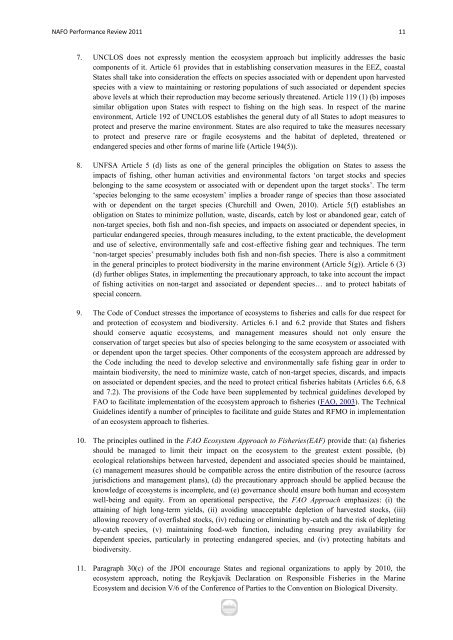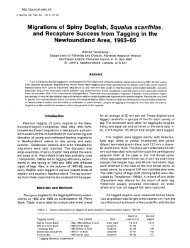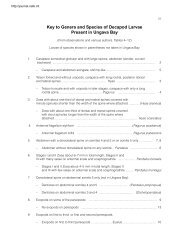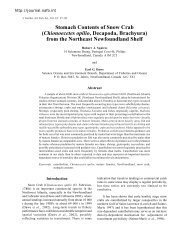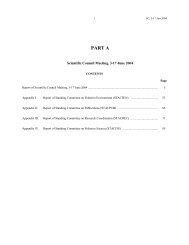Report of the NAFO Performance Review Panel - Northwest Atlantic ...
Report of the NAFO Performance Review Panel - Northwest Atlantic ...
Report of the NAFO Performance Review Panel - Northwest Atlantic ...
Create successful ePaper yourself
Turn your PDF publications into a flip-book with our unique Google optimized e-Paper software.
<strong>NAFO</strong> <strong>Performance</strong> <strong>Review</strong> 2011 117. UNCLOS does not expressly mention <strong>the</strong> ecosystem approach but implicitly addresses <strong>the</strong> basiccomponents <strong>of</strong> it. Article 61 provides that in establishing conservation measures in <strong>the</strong> EEZ, coastalStates shall take into consideration <strong>the</strong> effects on species associated with or dependent upon harvestedspecies with a view to maintaining or restoring populations <strong>of</strong> such associated or dependent speciesabove levels at which <strong>the</strong>ir reproduction may become seriously threatened. Article 119 (1) (b) imposessimilar obligation upon States with respect to fishing on <strong>the</strong> high seas. In respect <strong>of</strong> <strong>the</strong> marineenvironment, Article 192 <strong>of</strong> UNCLOS establishes <strong>the</strong> general duty <strong>of</strong> all States to adopt measures toprotect and preserve <strong>the</strong> marine environment. States are also required to take <strong>the</strong> measures necessaryto protect and preserve rare or fragile ecosystems and <strong>the</strong> habitat <strong>of</strong> depleted, threatened orendangered species and o<strong>the</strong>r forms <strong>of</strong> marine life (Article 194(5)).8. UNFSA Article 5 (d) lists as one <strong>of</strong> <strong>the</strong> general principles <strong>the</strong> obligation on States to assess <strong>the</strong>impacts <strong>of</strong> fishing, o<strong>the</strong>r human activities and environmental factors ‗on target stocks and speciesbelonging to <strong>the</strong> same ecosystem or associated with or dependent upon <strong>the</strong> target stocks‘. The term‗species belonging to <strong>the</strong> same ecosystem‘ implies a broader range <strong>of</strong> species than those associatedwith or dependent on <strong>the</strong> target species (Churchill and Owen, 2010). Article 5(f) establishes anobligation on States to minimize pollution, waste, discards, catch by lost or abandoned gear, catch <strong>of</strong>non-target species, both fish and non-fish species, and impacts on associated or dependent species, inparticular endangered species, through measures including, to <strong>the</strong> extent practicable, <strong>the</strong> developmentand use <strong>of</strong> selective, environmentally safe and cost-effective fishing gear and techniques. The term‗non-target species‘ presumably includes both fish and non-fish species. There is also a commitmentin <strong>the</strong> general principles to protect biodiversity in <strong>the</strong> marine environment (Article 5(g)). Article 6 (3)(d) fur<strong>the</strong>r obliges States, in implementing <strong>the</strong> precautionary approach, to take into account <strong>the</strong> impact<strong>of</strong> fishing activities on non-target and associated or dependent species… and to protect habitats <strong>of</strong>special concern.9. The Code <strong>of</strong> Conduct stresses <strong>the</strong> importance <strong>of</strong> ecosystems to fisheries and calls for due respect forand protection <strong>of</strong> ecosystem and biodiversity. Articles 6.1 and 6.2 provide that States and fishersshould conserve aquatic ecosystems, and management measures should not only ensure <strong>the</strong>conservation <strong>of</strong> target species but also <strong>of</strong> species belonging to <strong>the</strong> same ecosystem or associated withor dependent upon <strong>the</strong> target species. O<strong>the</strong>r components <strong>of</strong> <strong>the</strong> ecosystem approach are addressed by<strong>the</strong> Code including <strong>the</strong> need to develop selective and environmentally safe fishing gear in order tomaintain biodiversity, <strong>the</strong> need to minimize waste, catch <strong>of</strong> non-target species, discards, and impactson associated or dependent species, and <strong>the</strong> need to protect critical fisheries habitats (Articles 6.6, 6.8and 7.2). The provisions <strong>of</strong> <strong>the</strong> Code have been supplemented by technical guidelines developed byFAO to facilitate implementation <strong>of</strong> <strong>the</strong> ecosystem approach to fisheries (FAO, 2003). The TechnicalGuidelines identify a number <strong>of</strong> principles to facilitate and guide States and RFMO in implementation<strong>of</strong> an ecosystem approach to fisheries.10. The principles outlined in <strong>the</strong> FAO Ecosystem Approach to Fisheries(EAF) provide that: (a) fisheriesshould be managed to limit <strong>the</strong>ir impact on <strong>the</strong> ecosystem to <strong>the</strong> greatest extent possible, (b)ecological relationships between harvested, dependent and associated species should be maintained,(c) management measures should be compatible across <strong>the</strong> entire distribution <strong>of</strong> <strong>the</strong> resource (acrossjurisdictions and management plans), (d) <strong>the</strong> precautionary approach should be applied because <strong>the</strong>knowledge <strong>of</strong> ecosystems is incomplete, and (e) governance should ensure both human and ecosystemwell-being and equity. From an operational perspective, <strong>the</strong> FAO Approach emphasizes: (i) <strong>the</strong>attaining <strong>of</strong> high long-term yields, (ii) avoiding unacceptable depletion <strong>of</strong> harvested stocks, (iii)allowing recovery <strong>of</strong> overfished stocks, (iv) reducing or eliminating by-catch and <strong>the</strong> risk <strong>of</strong> depletingby-catch species, (v) maintaining food-web function, including ensuring prey availability fordependent species, particularly in protecting endangered species, and (iv) protecting habitats andbiodiversity.11. Paragraph 30(c) <strong>of</strong> <strong>the</strong> JPOI encourage States and regional organizations to apply by 2010, <strong>the</strong>ecosystem approach, noting <strong>the</strong> Reykjavik Declaration on Responsible Fisheries in <strong>the</strong> MarineEcosystem and decision V/6 <strong>of</strong> <strong>the</strong> Conference <strong>of</strong> Parties to <strong>the</strong> Convention on Biological Diversity.


